Article
Zavartseva Marina M. (2016). Structure and functions of organizational trust in employees’ notions. National Psychological Journal. 2, 94-104.
Abstract
This article investigates the structure and functions of organizational trust, examining the content of employees’ subjective notions about organizational trust and it’s role in organization’s functioning. The combination of direct (R.B.Shaw’s trust assessment survey) and indirect (the semantic differential scale; the content-analysis of the checklist of trust structural components) methods was used. Using data on 378 employees of different organizations (commercial, medical, educational) we distinguished subjective images of organization in groups with opposite estimation of organizational trust’s level. The study indicated that organizational trust’s structure is not linear, and exposed two main functions of high level of organizational trust – idealization and positive emotional estimation both of actual organization (that is currently place of employment). Obtained data provide basis for express-diagnostic of trust in organization and might be used for design of psychological training aiming high organization’s efficacy.
Accepted: 06/20/2016
Pages: 94-104
DOI: 10.11621/npj.2016.0209
PDF: Download
Keywords: psychology of labour; organizational trust; notions; psychosemantics; content analysis;
Available Online 30.08.2016
Table 1. Research Structure
|
Method of Research |
Analysis Object |
Contents |
|||
|
1. Trust level evaluation technique by Robert B. Shaw |
Sample division into two groups |
Group with high estimation of organizational trust level |
Group with low estimation of organizational trust level |
||
|
2. Standardized semantic differential with 25 scales |
Semantic universal of the object "The organization I am currently employed in" |
The basic differences are presented in the Picture 1 |
|||
|
Evaluated objects' position in the specified semantic space. |
The basic differences are presented in the Table 2 and in the Pictures 2-4 |
||||
|
3. Question answering analysis ("What word would you use to describe the organization you are employed in?") |
Organization subjective image (through the descriptive words according to expert evaluation) |
The basic differences are presented in the Tables 3 and 4 and in the Picture 5 |
|||
|
Awareness degree dedicated to organization subjective image |
Metaphors are 21% of answers |
Metaphors are 9,9% of answers |
|||
|
4. Questions answering analysis. Questions: 1) "What associations do you have with 'low organization trust level'? Could you list its indicators?" 2) "What associations do you have with 'high organization trust level'? Could you list its indicators?" |
Structure of organization trust indicators as understood by employees |
The structure is described in Table 5 |
|||
Figure 1. The differences and the similarities found during the evaluation of the object «The organization I am employed in» using the method of semantic differential and semantic universal in particular.
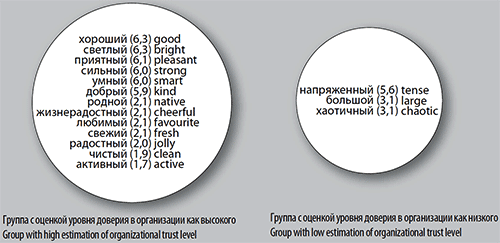
Table 2. Evaluated object coordinates in the specified semantic space
|
|
Evaluated Object |
Factors |
|||
|
Factor 1: positive – negative |
Factor 2: active – passive |
Factor 3: easy – difficult |
Factor 4: wet – dry |
||
|
Group with low estimation of organizational trust level |
"The organization that trusts me" |
0,15 |
-0,01 |
0,01 |
0,18 |
|
"The organization that I can trust" |
-0,29 |
-0,04 |
-0,27 |
0,26 |
|
|
"The organization I am currently employed in" |
1,27 |
0,31 |
0,69 |
-0,22 |
|
|
Group with high estimation of organizational trust level |
"The organization that trusts me" |
-0,29 |
-0,03 |
-0,20 |
-0,12 |
|
«Организация, которой я могу доверять» |
-0,41 |
-0,12 |
-0,35 |
-0,03 |
|
|
«Организация, в которой я работаю» |
-0,39 |
-0,04 |
-0,07 |
-0,12 |
|
Figure 2. The position of evaluated objects in the semantic space of factors «difficult – easy», «positive – negative».
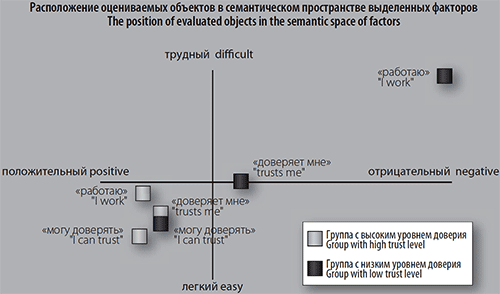
Figure 3. The position of evaluated objects in the semantic space of factors «difficult – easy», «passive – active».
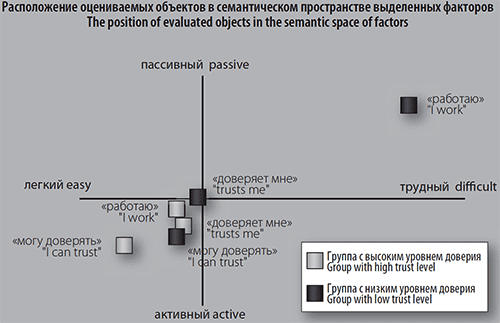
Figure 4. The position of evaluated objects in the semantic space of factors «positive – negative», «passive – active».

Table 3. Ordered list of descriptive words (based on frequency analysis method).
|
Descriptive Words |
average value of expert evaluation (n = 16) |
Word's number of mentions (the percentage counted from the overall number of mentions) |
|||
|
the whole sample (n = 378) |
group with high organizational trust level (n = 84) |
group with low organizational trust level (n = 76) |
|||
|
positive |
"trust" |
1,13 |
6 |
3 (50%) |
0 |
|
"family" |
1,19 |
16 |
14 (87,5%) |
0 |
|
|
"team" |
1,44 |
6 |
2 (33,3%) |
0 |
|
|
"home" |
1,44 |
14 |
14 (100%) |
0 |
|
|
"stability" |
1,50 |
6 |
1 (16,7%) |
0 |
|
|
"group" |
2,00 |
11 |
2 (18,2%) |
1 (9,1%) |
|
|
neutral |
"beehive" |
2,94 |
5 |
2 (40%) |
0 |
|
"anthill" |
3,06 |
5 |
1 (20%) |
1 (20%) |
|
|
negative |
"chaos" |
4,25 |
5 |
0 |
3 (60%) |
Figure 5. The proportion of descriptive words (n=10, frequency of mentioning ≥5) mentioning in groups with different organization trust level evaluation.
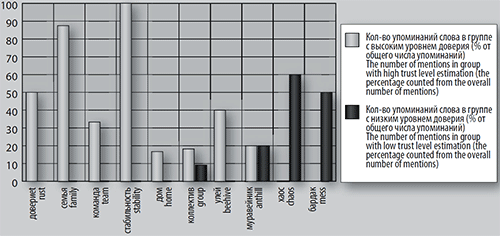
Table 4. Significant differences concerning the proportion of descriptive words with opposite evaluation (between the groups with dissimilar trust levels according to the Mann-Whitney U test).
|
|
Average rank (group 1, positive words, 17 people) |
Average rank group 2, negative words,7 people) |
Value z (p – the level of significance) |
|
The number of mentions in group with high trust level estimation |
16,6 |
5 |
-3,303 (p = 0,001) |
|
The number of mentions in group with low trust level estimation |
11,5 |
22,7 |
-4,171 (p = 0) |
Table 5. Two groups of organization trust level subjective indicators
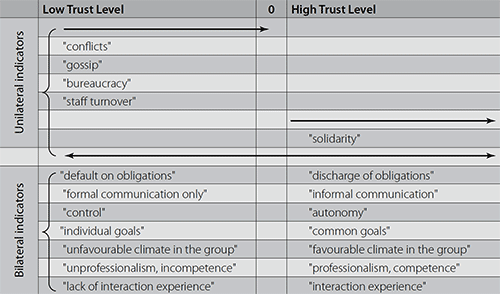
References:
Bachmann, R., & Inkpen, A.C. (2011) Understanding institutional-based trust building processes in inter-organizational relationships. Organization Studies. 32, Vol. 2, 281 – 301.
Burlachuk, L.F., Morozov, S.M. (1999) Psychodiagnosis glossary. Saint-Petersburg, Piter Kom, 528.
Clark, M.C., & Payne, R.L. (1997) The Nature and Structure of Workers’ Trust in Management. Journal of Organizational Behavior. 5, 205 – 224.
Colquitt, J.A., Lepine, J.A., Zapata, C.P., Piccolo, R.F., & Rich, B.L. (2012) Explaining the Justice–Performance Relationship: Trust as Exchange Deepener or Trust as Uncertainty Reducer? Journal of Applied Psychology. 97, Vol. 1, 1 – 15.
Fukuyama, F. (2004) Trust: the Social Virtues and the Creation of Prosperity. Moscow, OOO «Izdatel’stvo AST»: ZAO NPP «Ermak», 730.
Gebert, D., & Berner, S. (2005) Developing enterprise as an open system in economically difficult circumstances. Fraimut, I. (Ed.) Fear that managers feel at work. Kharkiv, Izdatel’stvo Gumanitarnyi tsentr, 416.
Kirchler, E., Meier-Pesti, K., & Hofmann, E. (2005) Psychological theories of organizations. Occupational and organizational psychology [Psikhologiya truda i organizatsionnaya psikhologiya]. Kharkiv, Izdatel’stvo Gumanitarnyi tsentr, Vol. 5, 312.
Kupreichenko, A.B. (2008) Trust and distrust psychology. Moscow, Izdatel’stvo «Institut psikhologii RAN», 571.
Luchko, M.L. (2006) Business ethics as a factor for success. Moscow, Izdatel’stvo Eksmo, 320.
Lyasko, A. (2003) Trust and transaction costs. Economic matters [Voprosy ekonomiki]. 1, 42 – 58.
Mayer, R.C., Davis, J.H., & Schoorman, F.D. (1995) An integrative model of organizational trust. Academy of Management Review. 20, Vol. 3, 709-734.
Mayer R.C., & M.B. (2005) Trust in management and performance: who minds the shop while the employees watch the boss? Academy of Management Journal. 48, Vol. 5, 874 – 888.
Rousseau, D.M., Sitkin, S.B., Burt, R.S., & Camerer, C. (1998) Not so different after all: a cross-discipline view of trust. Academy of Management Review. 23, Vol. 3, 393 – 404.
Seidl, D. (2005) Metaphorical self-description of an organization. Organizational communication [Organizatsionnaya kommunikatsiya]. Kharkiv, Izdatel’stvo Gumanitarnyi tsentr, 248 – 273.
Serkin, V.P. (2004) Psychosemantic methods. Moscow, Aspekt-Press, 207.
Serkin, V. P. (2009) Randomness/nonrandomness of associations task solution: evaluation criteria and valid set of associations. Psychodiagnosis [Psikhodiagnostika]. 4, 22–31.
Shaw, R. B. (2000) Keys to the organizational trust. Moscow, Delo, 272.
Sidorenkov, A.V., & Sidorenkova, I.I. (2013). Model of trust in work groups. Psychology in Russia: State of the Art. 6, Vol. 3, 164 – 176.
Bazarova, T.Yu., & B.L.Eremina (Ed.) (2001) Managing staff: a university course. Moscow, YuNITI, 560.
Zinchenko, V.P. (2005) Trust. Big psychological dictionary. Saint-Petersburg, PRAIM EVROZNAK, 143-145.
Zinchenko, Yu.P., & Busygina, I.S. (2013) Mental health and professional self-actualization of a leader. National psychological journal [Natsional’nyy psikhologicheskiy zhurnal]. 1, Vol. 9, 89–95. DOI: 2079-6617/2013.0112
For citing this article:
Zavartseva Marina M. (2016). Structure and functions of organizational trust in employees’ notions. National Psychological Journal. 2, 94-104.


